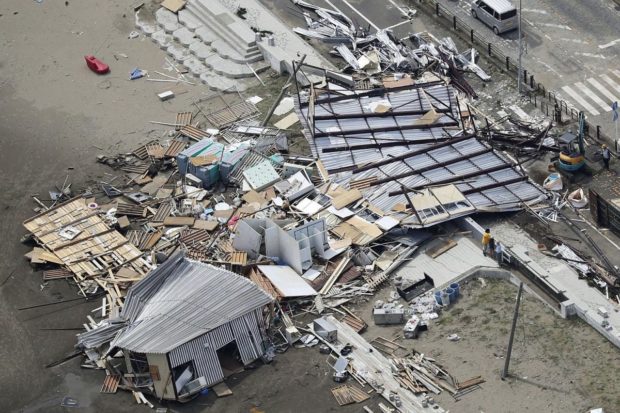Typhoon terror in Japan and the Koreas

Beach houses left destroyed after Typhoon Faxai hit the beachfront area in Miura, south of Tokyo, yesterday. It was the most powerful storm to hit the region in years and left nearly a million people without electricity at one point. ASSOCIATED PRESS via The Straits Times/Asia News Network
SINGAPORE — Residents in eastern Japan and North and South Korea were cleaning up Monday after two powerful typhoons damaged homes, toppled power lines and disrupted transport links, the latest storms to hit East Asia.
With the typhoon season in the north-west Pacific expected to peak next month, more death and destruction are expected in the coming weeks.
Typhoon Lingling swiped western South Korea before heading across North Korea over the weekend, while Typhoon Faxai struck the Tokyo region early yesterday. Faxai was the most powerful storm to hit Tokyo in years and left nearly a million people without electricity at one point.
Lingling killed five people in North Korea and three in South Korea. It also damaged crops in the North, a major concern for a country already facing food shortages.
North Korean state media urged citizens yesterday to “fully mobilise” to rebuild, and workers were restoring electricity networks, salvaging battered crops and helping families whose homes and property were damaged.
Article continues after this advertisementThe North’s official Rodong Sinmun newspaper said strong winds and rain damaged hundreds of homes and dozens of public buildings, and caused problems for crops on 46,200ha of farmland.
Article continues after this advertisementRodong Sinmun said officials and workers were engaged in an “intense struggle” to repair power systems in several towns, including Kaesong, Pongsan, Jaeryong and Paechon, removing toppled telephone poles and steel towers and building emergency electricity networks to use until utilities are fully restored.
It said power plants were also boosting electricity production to support recovery efforts. Workers and soldiers in major farming areas such as South Hwanghae province and South Pyongan province scrambled to drain flooded fields and rice paddies and tend to fallen rice plants and corn, the newspaper said.
The typhoons struck a week after Hurricane Dorian, one of the most powerful hurricanes on record in the Atlantic, smashed into northern Bahamas before causing flooding and damage in south-eastern United States and then far eastern Canada.
Rescuers are still picking their way through the ruins in the Bahamas where the death toll has risen to 44, with expectations that it will rise further. Dorian was also blamed for five deaths in the south-eastern US and one in Puerto Rico.
Thousands have been left homeless in the Bahamas and about 70,000 need food and shelter, according to an estimate by the United Nations’ World Food Programme, Reuters reported.
The hardest-hit island of Great Abaco in the Bahamas was littered with mounds of unused construction materials, waterlogged notebooks and Bibles, stained piles of tattered clothes, single shoes, overturned bathtubs and rotting mattresses. Dead cats and dogs were strewn throughout the wreckage, while some stray animals were digging through the garbage for food and had taken up residence on the porches of destroyed homes, Reuters said.
The storm caused so much damage in part because it stalled over the northern Bahamas, lashing it for two days with winds of 295kmh and flooding rain.
Climate scientists say tropical storms such as typhoons, cyclones and hurricanes are set to become stronger in coming years, fuelled by warmer waters as the planet continues to heat up – the ocean absorbs most of the excess heat trapped by accumulating greenhouse gas emissions in the atmosphere. Wind speeds will increase, along with the amount of rainfall the storms bring.
Storms are also predicted to shift farther north and south, and recent research suggests storms are also slowing down as they cross the ocean, meaning they will dump more flooding rain and cause more damage once they hit land.
Research published in the journal Nature last year found that rising global temperatures could be disrupting global circulation patterns, causing tropical storms to slow down. The researchers found that the speed at which they travel across the earth has slowed by an average of 10 per cent over the past 70 years, with the speed of storms originating in the north-west Pacific falling by 30 per cent.
Hurricane Harvey is an example of a tropical storm that stalled, dumping a record amount of rain over parts of Texas for a week between late August and early September in 2017, making it one of the US’ costliest natural disasters.
A year later, Hurricane Florence lingered over the Carolinas in the US south-east, causing widespread flooding there.
“We’re seeing the future of major hurricanes,” Mr Jeff Masters, co-founder of Weather Underground, told Bloomberg, referring to Dorian. “They intensify faster and move slower.”
Also referring to Dorian, Mr Ryan Truchelut, chief meteorologist at WeatherTiger in Tallahassee, Florida, told Bloomberg: “There has never been anything like it.
“We’ve never seen a Category 5 storm stall like that over one point for 36 hours. The energy it unleashed in such a small area has never happened before in the Atlantic.”
So far, the typhoon season in the north-west Pacific is close to being average. The season runs throughout the year, with most storms developing in the May-to-October period. But powerful storms can still occur in November and December. Deadly Typhoon Haiyan struck the Philippines in early November 2013.
Storm forecasting and tracking site Tropical Storm Risk, run by University College London, foresees a slightly below average typhoon season this year. It is forecasting 26 tropical storms, 16 typhoons and eight intense typhoons, compared with the 1965-2018 average of nine intense typhoons.